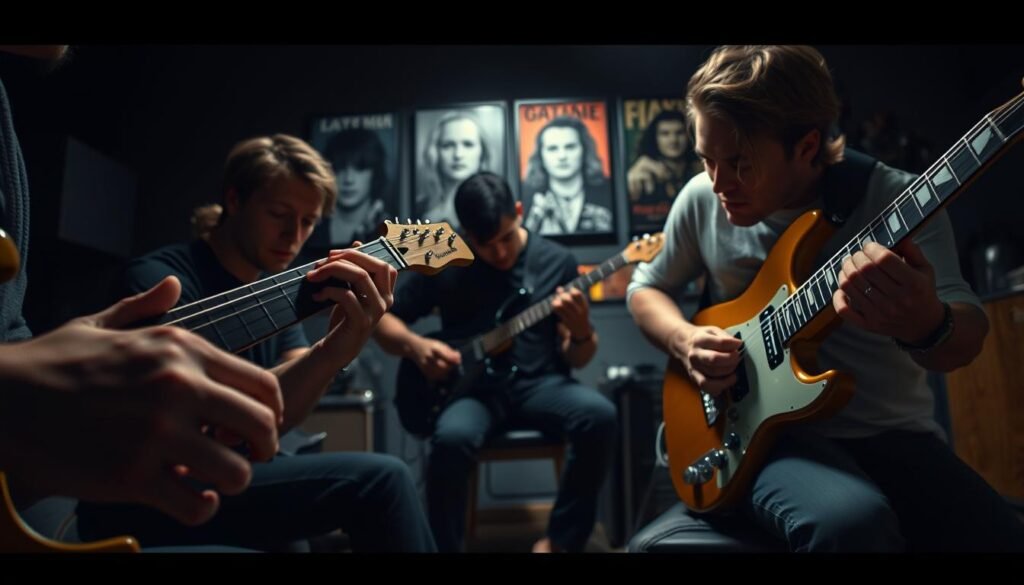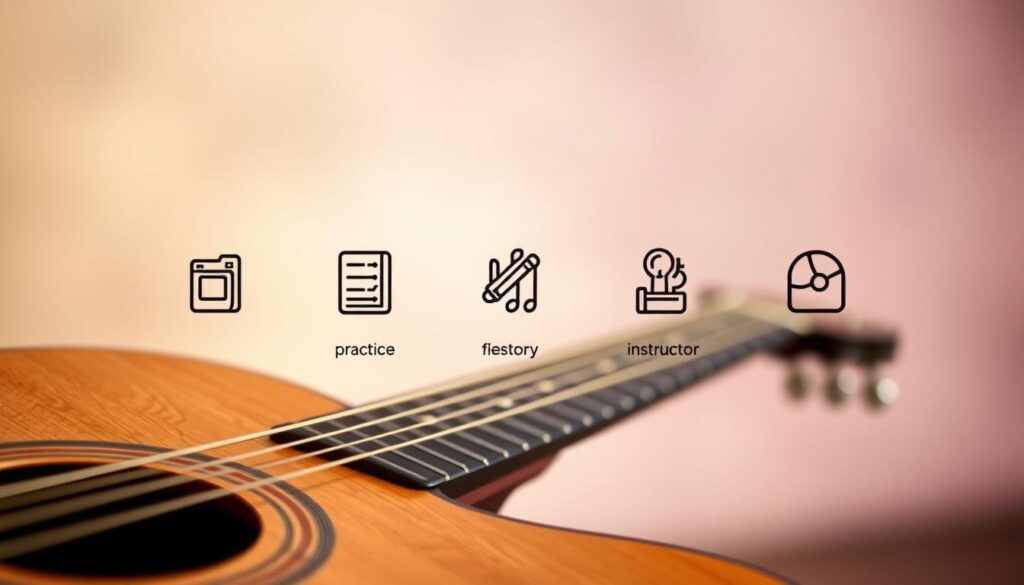Ever wondered why some people strum chords effortlessly while others struggle for months? Mastering the guitar isn’t about ticking days off a calendar—it’s about persistence, smart practice, and embracing the journey. Legendary players like Eddie Van Halen didn’t become icons overnight. They dedicated hours to refining their craft.
Progress depends on your goals. Want to play campfire songs? A few weeks of practice might suffice. Aiming for solos? That requires more time. Finger pain and coordination challenges are normal, but consistency turns frustration into skill.
This guide breaks down realistic milestones, from basic chords to advanced techniques. You’ll learn how to measure progress and avoid common pitfalls. Ready to transform confusion into confidence?
Key Takeaways
- Progress varies based on goals and practice habits.
- Mastery is a journey, not a deadline.
- Early struggles like finger pain fade with persistence.
- Focus on measurable improvements, not comparisons.
- Structured routines accelerate skill development.
Understanding the Guitar Learning Journey
Slash’s 12-hour practice sessions reveal a truth: mastery demands tailored dedication. Progress depends on your goals, biology, and how you train. While some players nail chords in weeks, others spend years refining techniques. The difference? It’s not just time—it’s how you use it.
Why Timeframes Vary for Every Learner
Malcolm Gladwell’s 10,000-hour rule applies to guitar, but few hit that mark. Biological factors matter. Hand strength and coordination develop at unique speeds. Muscle memory grows faster with focused practice.
Data shows learners drilling 1+ hours daily see results in 6 months. Yet 95% struggle due to inconsistent routines or poor techniques. Structured sessions beat random YouTube tutorials every time.
Defining “Good” in Guitar Playing
“Good” is subjective. Campfire strumming requires basic skills. Shredding solos? That’s a multi-year process. Set realistic milestones. Celebrate small wins like clean chord transitions.
Avoid comparing your day 30 to someone’s decade of playing. Focus on incremental growth. Your journey is yours alone.
How Long Does It Take to Learn Guitar? A Phase-by-Phase Breakdown
The path to guitar mastery unfolds in distinct stages, each with its own challenges and rewards. Whether you’re strumming open chords or mastering modal scales, progress depends on consistent practice and clear milestones. Below, we map out typical timelines—but remember, your journey may vary.

Beginner Phase (0-6 Months): Building Foundations
First months focus on fundamentals. Calluses form, and basic chords like E, A, and C become familiar. Simple strumming patterns let you play songs like “Hey, Soul Sister” within weeks.
Finger coordination improves daily. Expect awkward transitions at first, but persistence pays off. By month six, campfire singalongs feel achievable.
Advanced Beginner (6 Months – 1 Year): Overcoming Plateaus
Progress slows as you tackle alternate picking and fretboard navigation. This phase tests patience—many quit here. Push through by learning pentatonic scales or fingerstyle patterns.
Plateaus break with targeted drills. Celebrate small wins, like cleanly switching between barred and open positions.
Intermediate (1-2 Years): Comfort and Confidence
Barre chords and improvisation mark this stage. You’ll explore genres—blues bends, rock riffs—and play along with backing tracks. Skills feel more automatic.
Transitions smooth out, and you’ll start developing a personal style. Jamming with others boosts confidence.
Advanced (2-5+ Years): Mastery and Refinement
Here, technique meets artistry. Dive into modes, arpeggios, and advanced vibrato. Guitarists like John Mayer spend years refining tone and phrasing.
Specialization happens—maybe jazz harmony or shredding. Tools like the Zager ZAD50 guitar support ergonomic playing for marathon sessions.
Key Factors That Affect Your Progress
Your guitar journey accelerates or stalls based on three controllable factors. Consistency, guidance, and mindset determine whether you’ll plateau or break through barriers. Even legends like Eric Clapton battled chord changes before refining their craft.

Practice Consistency vs. Intensity
Thirty-minute daily sessions outperform marathon weekend practices. Progress thrives on repetition. Muscle memory builds faster with regular, focused drills.
Use tools like metronomes for rhythm and apps like Guitar Tuna for tuning. Structured routines reduce wasted time. Gladwell’s 10,000-hour rule applies—but only if hours are intentional.
The Role of Quality Instruction
Structured lessons slash learning time by 30%. Instructors spot posture flaws and correct techniques early. Self-taught players often develop bad habits.
Case studies show students with teachers advance twice as fast. Online or in-person, feedback is invaluable. Fishman electronics in guitars like the Zager Travel model aid precise practice.
Mindset and Motivation
Plateaus signal growth, not failure. Embrace them. A player’s attitude shapes their trajectory. Celebrate small wins—clean chord transitions or smoother picks.
Tools matter, but persistence is king. Remember: every virtuoso once fumbled through their first scales.
How to Speed Up Your Guitar Learning Process
What separates fast learners from those stuck in beginner limbo? Smart practice habits. Progress hinges on how you structure your time and tackle challenges. Below, we break down three proven strategies to accelerate your skills.
Structured Practice Routines
Random noodling won’t cut it. Design a 30-minute daily plan: 10 minutes on chords, 10 on scales, and 10 applying both to songs. Tools like the Zager ZAD50’s soft-touch frets reduce finger strain, letting you practice longer.
Metronomes are game-changers. Start slow, then incrementally increase speed. This way, muscle memory develops without sloppy habits.
Focusing on Weaknesses Early
Identify stumbling blocks—maybe barre chords or alternate picking. Drill them first in each session. Use backing tracks to sharpen improvisation techniques.
Case studies show learners who target weaknesses improve 40% faster. The Ibanez PC12MHCE’s cutaway design helps access tricky upper frets during drills.
Using the Right Resources
Quality matters. Apps like Fender Play offer structured lessons, while Songsterr provides accurate tablature. Gamified platforms like Yousician make repetition engaging.
Pair tools with ergonomic gear. A slim-neck guitar, like the Zager Travel Size, minimizes fatigue during marathon sessions.
Conclusion: Embrace the Journey, Not Just the Destination
Playing the guitar isn’t about reaching a finish line—it’s a lifelong journey. Even legends like Steve Vai still refine their craft after decades. Progress comes in waves, not straight lines.
Track your growth with video recordings or a practice journal. Small wins add up. Starting with an acoustic builds finger strength, making electric guitar easier later.
Share your milestones below—maybe your first song or a tricky chord mastered. As one player put it: “Music is a journey where practice becomes a way of life.” Keep strumming, and enjoy every step.
FAQ
What’s the average time to play basic chords?
Most beginners can strum simple chords like G, C, and D within 1-3 months with regular practice.
Can I learn guitar without a teacher?
Yes! Many players use online lessons, apps like Fender Play, or YouTube tutorials. However, a teacher can accelerate progress.
How many hours of practice are needed weekly?
Aim for 30-60 minutes daily. Consistency matters more than marathon sessions—short, focused practice yields better results.
What’s the hardest part of learning guitar?
Finger pain and chord transitions frustrate beginners. Building calluses and muscle memory takes time but gets easier.
How long before I can play full songs?
Simple songs like “Wonderwall” or “Horse with No Name” take 3-6 months. Complex tracks may require 1-2 years.
Does age affect learning speed?
Kids often learn faster due to neuroplasticity, but adults excel with discipline. It’s never too late to start.
Should I start with acoustic or electric?
Acoustic builds finger strength; electric is easier on hands. Choose based on the music you love—motivation trumps gear.
How important is music theory?
Basics like scales and chord structures help, but you can play songs without deep theory. Learn it gradually.



